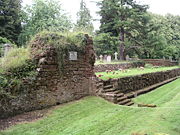
St Mary's Abbey, Kenilworth
Encyclopedia




Kenilworth
Kenilworth is a town in central Warwickshire, England. In 2001 the town had a population of 22,582 . It is situated south of Coventry, north of Warwick and northwest of London....
, Warwickshire
Warwickshire
Warwickshire is a landlocked non-metropolitan county in the West Midlands region of England. The county town is Warwick, although the largest town is Nuneaton. The county is famous for being the birthplace of William Shakespeare...
, England
England
England is a country that is part of the United Kingdom. It shares land borders with Scotland to the north and Wales to the west; the Irish Sea is to the north west, the Celtic Sea to the south west, with the North Sea to the east and the English Channel to the south separating it from continental...
are situated in the grounds of St Nicholas' Church
St Nicholas' Church, Kenilworth
St Nicholas' Church is situated a short distance south of High Street in the Warwickshire town of Kenilworth, England, and is a fine example of an English parish church in Perpendicular style with Tudor alterations, in the handsome red sandstone of the region...
and in an adjacent area of Abbey Fields. Some of its ruins are above ground and some are below ground.
History
A prioryPriory
A priory is a house of men or women under religious vows that is headed by a prior or prioress. Priories may be houses of mendicant friars or religious sisters , or monasteries of monks or nuns .The Benedictines and their offshoots , the Premonstratensians, and the...
for Augustinian
Augustinians
The term Augustinians, named after Saint Augustine of Hippo , applies to two separate and unrelated types of Catholic religious orders:...
canon
Canon (priest)
A canon is a priest or minister who is a member of certain bodies of the Christian clergy subject to an ecclesiastical rule ....
s was built on this site in about 1124 by Geoffrey de Clinton
Geoffrey de Clinton
Geoffrey de Clinton was an Anglo-Norman noble, chamberlain and treasurer to King Henry I of England. He was foremost amongst the men king Henry "raised from the dust". He married Lescelina.-Life:Clinton's family origins are a little obscure...
, which is about the same time as he built Kenilworth Castle
Kenilworth Castle
Kenilworth Castle is located in the town of the same name in Warwickshire, England. Constructed from Norman through to Tudor times, the castle has been described by architectural historian Anthony Emery as "the finest surviving example of a semi-royal palace of the later middle ages, significant...
. Gardens and pools were made near to the priory, and the priory gained additional land as gifts from Geoffrey de Clinton. A barn, a gatehouse, a belltower and an infirmary were subsequently built near to the main buildings of the priory, and St Nicholas' Church was built nearby in about 1291. The priory gradually gained wealth and the Pope upgraded its status to an abbey in 1447. St Mary's Abbey was signed over to King Henry VIII
Henry VIII of England
Henry VIII was King of England from 21 April 1509 until his death. He was Lord, and later King, of Ireland, as well as continuing the nominal claim by the English monarchs to the Kingdom of France...
in 1538 and then dismantled at part of the Dissolution of the Monasteries
Dissolution of the Monasteries
The Dissolution of the Monasteries, sometimes referred to as the Suppression of the Monasteries, was the set of administrative and legal processes between 1536 and 1541 by which Henry VIII disbanded monasteries, priories, convents and friaries in England, Wales and Ireland; appropriated their...
. By about 1700 most of the abbey had become ruins except for the gatehouse and the barn. The ruins were excavated in 1840, 1880 and 1922, and most of the ruins were covered in 1967 for their protection.

